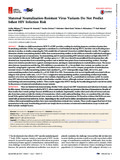| dc.description.abstract | Mother-to-child transmission (MTCT) of HIV provides a setting for studying immune correlates of protection. Neutralizing antibodies (NAbs) are suggested to contribute to a viral bottleneck during MTCT, but their role in blocking transmission is unclear, as studies comparing the NAb sensitivities of maternal viruses have yielded disparate results. We sought to determine whether transmitting mothers differ from nontransmitting mothers in the ability to neutralize individual autologous virus variants present at transmission. Ten transmitting and 10 nontransmitting HIV-infected mothers at high risk of MTCT were included in this study. Full-length HIV envelope genes (n = 100) were cloned from peripheral blood mononuclear cells obtained near transmission from transmitting mothers and at similar time points from nontransmitting mothers. Envelope clones were tested as pseudoviruses against contemporaneous, autologous maternal plasma in neutralization assays. The association between transmission and the log2 50% inhibitory concentration (IC50) for multiple virus variants per mother was estimated by using logistic regression with clustered standard errors. t tests were used to compare proportions of neutralization-resistant viruses. Overall, transmitting mothers had a median IC50 of 317 (interquartile range [IQR], 202 to 521), and nontransmitting mothers had a median IC50 of 243 (IQR, 95 to 594). Transmission risk was not significantly associated with autologous NAb activity (odds ratio, 1.25; P = 0.3). Compared to nontransmitting mothers, transmitting mothers had similar numbers of or fewer neutralization-resistant virus variants, depending on the IC50 neutralization resistance cutoff. In conclusion, HIV-infected mothers harbor mostly neutralization-sensitive viruses, although resistant variants were detected in both transmitting and nontransmitting mothers. These results suggest that MTCT during the breastfeeding period is not driven solely by the presence of maternal neutralization escape variants. | en_US |



